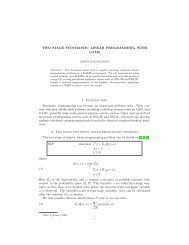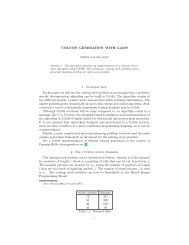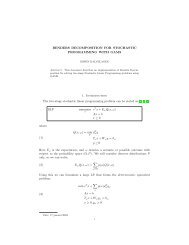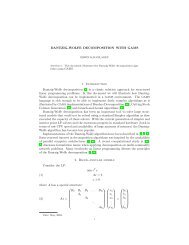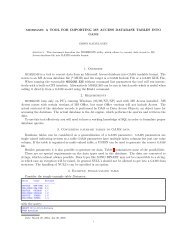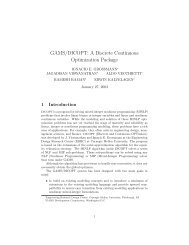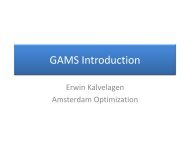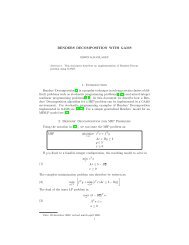Lagrangian Relaxation with GAMS - Amsterdam Optimization ...
Lagrangian Relaxation with GAMS - Amsterdam Optimization ...
Lagrangian Relaxation with GAMS - Amsterdam Optimization ...
You also want an ePaper? Increase the reach of your titles
YUMPU automatically turns print PDFs into web optimized ePapers that Google loves.
LAGRANGIAN RELAXATION WITH <strong>GAMS</strong><br />
ERWIN KALVELAGEN<br />
Abstract. This document describes an implementation of <strong>Lagrangian</strong> <strong>Relaxation</strong><br />
using <strong>GAMS</strong>.<br />
1. Introduction<br />
<strong>Lagrangian</strong> <strong>Relaxation</strong> techniques [2, 3] form an important and popular tool in<br />
discrete optimization. We will show how <strong>Lagrangian</strong> <strong>Relaxation</strong> <strong>with</strong> subgradient<br />
optimization can be implemented in a <strong>GAMS</strong> environment.<br />
2. <strong>Lagrangian</strong> <strong>Relaxation</strong><br />
We consider the Mixed Integer Programming model:<br />
MIP minimize<br />
x<br />
z = c T x<br />
Ax ≥ b<br />
Bx ≥ d<br />
x ≥ 0<br />
xj ∈ {0, 1, . . . , n} for j ∈ J<br />
There are two sets of linear constraints. We assume the set Ax ≥ b are the complicating<br />
constraints: if we relax the problem by removing these constraints, the<br />
remaining problem<br />
(1)<br />
min c T x<br />
Bx ≥ d<br />
x ≥ 0<br />
is relatively easy to solve.<br />
We can form the <strong>Lagrangian</strong> Dual:<br />
(2)<br />
xj ∈ {0, 1, . . . , n} for j ∈ J<br />
L(u) = min c T x + u T (b − Ax)<br />
Bx ≥ d<br />
x ≥ 0<br />
xj ∈ {0, 1, . . . , n} for j ∈ J<br />
For any u ≥ 0, L(u) forms a lower bound on problem MIP, as u T (b − Ax) ≤ 0. I.e.<br />
we have L(u) ≤ z.<br />
The task is to find<br />
(3) max<br />
u≥0 L(u)<br />
Date: 20 december 2002, revised may 2009.<br />
1
2 ERWIN KALVELAGEN<br />
which can provide a better bound than a linear programming relaxation. I.e.<br />
(4) zLP ≤ max L(u) ≤ z<br />
u≥0<br />
where zLP is the optimal objective of the linear programming relaxation.<br />
3. Subgradient <strong>Optimization</strong><br />
It can be shown that L(u) is a piecewise linear function. Solving (3) is therefore<br />
a nondifferentiable optimization problem. A successful technique for this problem<br />
is Subgradient <strong>Optimization</strong>.<br />
Following the notation in [5], the subgradient algorithm can be summarized as:<br />
{Input}<br />
An upper bound L ∗<br />
An initial value u 0 ≥ 0<br />
{Initialization}<br />
θ0 := 2<br />
{Subgradient iterations}<br />
for j := 0, 1, . . . do<br />
γ j := g(x j ) {gradient of L(u j )}<br />
tj := θj(L ∗ − L(u j ))/||γ j || 2 {step size}<br />
u j+1 := max{0, u j + tjγ j }<br />
if ||u j+1 − u j || < ε then<br />
Stop<br />
end if<br />
if no progress in more than K iterations then<br />
θj+1 := θj/2<br />
else<br />
θj+1 := θj<br />
end if<br />
j := j + 1<br />
end for<br />
There are many variants possible <strong>with</strong> respect to the calculation of the step size<br />
and the updating of the parameter θ [1, 4].<br />
4. Example<br />
In the <strong>GAMS</strong> model below we illustrate the technique described above using a<br />
generalized assignment problem:<br />
(5)<br />
min <br />
i<br />
j<br />
ci,jxi,j<br />
<br />
xi,j = 1 ∀i<br />
j<br />
<br />
ai,jxi,j ≤ bj ∀j<br />
i<br />
The assignment constraint <br />
j xi,j = 1 will be dualized. The resulting obtained<br />
bound of 12.5 is tighter than the LP relaxation bound of 6.4. To be complete, the<br />
optimal MIP solution is 18.
Model lagrel.gms. 1<br />
$ontext<br />
<strong>Lagrangian</strong> <strong>Relaxation</strong><br />
using a Generalized Assignment Problem<br />
LP <strong>Relaxation</strong> : 6.4286<br />
<strong>Lagrangian</strong> <strong>Relaxation</strong> : 12.5<br />
Optimal Integer Solution : 18<br />
Erwin Kalvelagen, <strong>Amsterdam</strong> <strong>Optimization</strong><br />
Reference:<br />
Richard Kipp Martin, Large Scale Linear and Integer <strong>Optimization</strong>,<br />
Kluwer, 1999<br />
$offtext<br />
set i ’tasks’ /i1*i3/;<br />
set j ’servers’ /j1*j2/;<br />
parameter b(j) ’available resources’ /<br />
j1 13<br />
j2 11<br />
/;<br />
table c(i,j) ’cost coefficients’<br />
j1 j2<br />
i1 9 2<br />
i2 1 2<br />
i3 3 8<br />
;<br />
table a(i,j) ’resource usage’<br />
j1 j2<br />
i1 6 8<br />
i2 7 5<br />
i3 9 6<br />
;<br />
*--------------------------------------------------------------------<br />
* standard MIP problem formulation<br />
* solve as RMIP to get initial values for the duals<br />
*--------------------------------------------------------------------<br />
variables<br />
cost ’objective variable’<br />
x(i,j) ’assignments’<br />
;<br />
binary variable x;<br />
equations<br />
obj ’objective’<br />
assign(i) ’assignment constraint’<br />
resource(j) ’resource limitation constraint’<br />
;<br />
obj.. cost =e= sum((i,j), c(i,j)*x(i,j));<br />
assign(i).. sum(j, x(i,j)) =e= 1;<br />
resource(j).. sum(i, a(i,j)*x(i,j)) =l= b(j);<br />
option optcr=0;<br />
model genassign /obj,assign,resource/;<br />
solve genassign minimizing cost using rmip;<br />
1 http://www.amsterdamoptimization.com/models/lagrel.gms<br />
3
4 ERWIN KALVELAGEN<br />
*---------------------------------------------------------------------<br />
* <strong>Lagrangian</strong> dual<br />
* Let assign be the complicating constraint<br />
*---------------------------------------------------------------------<br />
parameter u(i);<br />
variable bound;<br />
equation LR ’lagrangian relaxation’;<br />
LR.. bound =e= sum((i,j), c(i,j)*x(i,j))<br />
+ sum(i, u(i)*[1-sum(j,x(i,j))]);<br />
model ldual /LR,resource/;<br />
*---------------------------------------------------------------------<br />
* subgradient iterations<br />
*---------------------------------------------------------------------<br />
set iter /iter1*iter50/;<br />
scalar continue /1/;<br />
parameter stepsize;<br />
scalar theta /2/;<br />
scalar noimprovement /0/;<br />
scalar bestbound /-INF/;<br />
parameter gamma(i);<br />
scalar norm;<br />
scalar upperbound;<br />
parameter uprevious(i);<br />
scalar deltau;<br />
parameter results(iter,*);<br />
*<br />
* initialize u <strong>with</strong> relaxed duals<br />
*<br />
u(i) = assign.m(i);<br />
display u;<br />
*<br />
* an upperbound on L<br />
*<br />
parameter initx(i,j) / i1.j1 1, i2.j2 1, i3.j2 1 /;<br />
upperbound = sum[(i,j), c(i,j)*initx(i,j)];<br />
display upperbound;<br />
loop(iter$continue,<br />
*<br />
* solve the lagrangian dual problem<br />
*<br />
option optcr=0;<br />
option limrow = 0;<br />
option limcol = 0;<br />
ldual.solprint = 0;<br />
solve ldual minimizing bound using mip;<br />
results(iter,’dual obj’) = bound.l;<br />
if (bound.l > bestbound,<br />
bestbound = bound.l;<br />
display bestbound;<br />
noimprovement = 0;<br />
else<br />
noimprovement = noimprovement + 1;<br />
if (noimprovement > 1,<br />
theta = theta/2;<br />
noimprovement = 0;<br />
);<br />
);<br />
results(iter,’noimprov’) = noimprovement;
esults(iter,’theta’) = theta;<br />
*<br />
* calculate step size<br />
*<br />
gamma(i) = 1-sum(j,x.l(i,j));<br />
norm = sum(i,sqr(gamma(i)));<br />
stepsize = theta*(upperbound-bound.l)/norm;<br />
results(iter,’norm’) = norm;<br />
results(iter,’step’) = stepsize;<br />
*<br />
* update duals u<br />
*<br />
uprevious(i) = u(i);<br />
u(i) = max(0, u(i)+stepsize*gamma(i));<br />
display u;<br />
*<br />
* converged ?<br />
*<br />
deltau = smax(i,abs(uprevious(i)-u(i)));<br />
results(iter,’deltau’) = deltau;<br />
if( deltau < 0.01,<br />
display "Converged";<br />
continue = 0;<br />
);<br />
);<br />
display results;<br />
References<br />
1. M. S. Bazaraa and H. D. Sherali, On the choice of step sizes in subgradient optimization,<br />
Journal of Operational Research 7 (1981), 380–388.<br />
2. Marshall L. Fisher, An applications oriented guide to lagrangian relaxation, Interfaces 15<br />
(1985), no. 2, 10–21.<br />
3. A. M. Geoffrion, <strong>Lagrangian</strong> relaxation and its uses in integer programming, Mathematical<br />
Programming Study 2 (1974), 82–114.<br />
4. M. H. Held, P. Wolfe, and H. D. Crowder, Validation of subgradient optimization, Mathematical<br />
Programming 6 (1974), no. 1, 62–88.<br />
5. Richard Kipp Martin, Large scale linear and integer optimization; a unified approach, Kluwer,<br />
1999.<br />
<strong>Amsterdam</strong> <strong>Optimization</strong> Modeling Group., Washington D.C./The Hague<br />
E-mail address: erwin@amsterdamoptimization.com<br />
5



